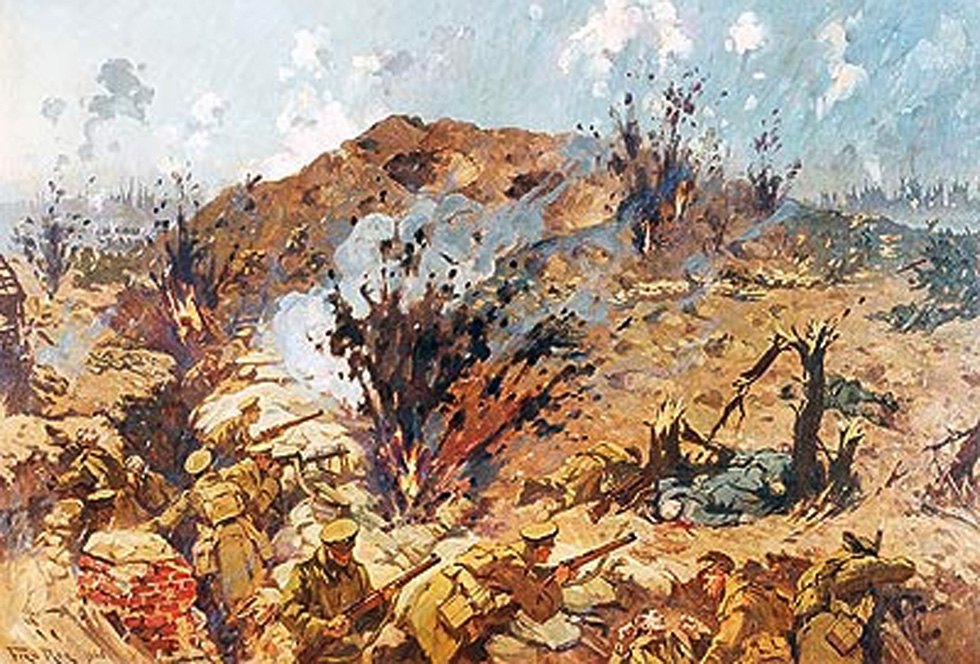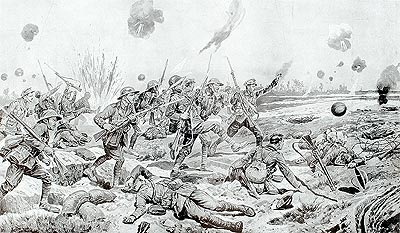 The East Surrey Regiment in the First World War
The East Surrey Regiment in the First World War
The 1st Battalion
On 4th August 1914, the 1st Bn The East Surrey Regiment was in Dublin. Eleven days later, mobilization completed and at full war establishment, the Battalion was in France, and before the end of the month was in action against the Germans. During the Retreat from Mons and afterwards, the Battalion took part in the great battles of 1914, Le Cateau, the Marne and the Aisne. In 1915, after the Battle of La Bassée, the 1st Surreys withstood a most determined attack on Hill 60, near Ypres. In the desperate fighting which ensued, the Battalion won three Victoria Crosses and seven Distinguished Conduct Medals. Among the VCs was Lieutenant Roupell, who later became the last Colonel of The East Surrey Regiment. The casualties in this short action alone amounted to 113 killed and 165 wounded.
 |
| The Defence of Hill 60. (Click image to enlarge) |
In 1916, the 1st Battalion took part in the great battles of the River Somme, and distinguished itself notably at Morval in September. The Battalion took part in many of the great battles of 1917, such as Arras, the Third Battle of Ypres and, perhaps the worst, Passchendaele. After a four month tour on the Italian Front, the Battalion was back in France in March 1918, and was engaged in the Battles of Albert and Bapaume, and the subsequent advance to victory.
The 2nd Battalion
The Battalion returned from India at the outbreak of war, but it was not until January 1915 that it arrived in France. It was soon in action to the south of Ypres where it lost many men, some by poison gas. In the Battle of St Julien, the Battalion had 141 killed and 256 wounded. A week later it lost a further 100 killed and 133 wounded.
The 2nd Battalion took part in the Battle of Loos in September 1915, and fought valiantly in the defence of the Hohenzollern Redoubt. At a vital stage in this battle, Lieutenant Fleming-Sandes, though wounded, displayed exceptional courage and leadership, for which he was later awarded the Victoria Cross. The following month the Battalion was transferred to the Salonika Expeditionary Force, and spent the remainder of the War on the Struma, Valley Front and east of Lake Doiran. The summer heat in Macedonia was intense, but the principal scourge was malaria, which at one period reduced the strength of the Battalion to 186 Other Ranks.
The Territorial Battalions
The 5th and 6th Battalions of The East Surrey Regiment were not to see service on the Western Front. They embarked for India in October 1914 and were employed on garrison duties in the United Provinces and the Punjab for two years. The 5th Battalion then joined the Mesopotamia Expeditionary Force and took part in the operations on the Tigris, while the 6th Battalion left India for a twelve month tour of duty with the Aden Field Force. This Battalion returned from India for demobilization in 1919, but the 5th Surreys, who were engaged on active operations in Southern Khurdistan until late December, did not reach home until February 1920. Both were resuscitated in 1921 with the rest of the TA.
In the late 1930s the 5th Bn converted to Royal Artillery and in 1939 the 6th Bn, which by then was over 1200 strong, was divided into the 1/6th and 2/6th Surreys.
The Service Battalions - Kitchener’s Army
The East Surrey Regiment raised seven Service battalions, of which the 7th, 8th, 9th (the Gallants), 12th and 13th served in France. All these non-Regular battalions had fine fighting records, and in every way maintained the traditions of the Regiment, enhancing its prestige by their gallantry and endurance. All took part in the Battles of the Somme in 1916. Most were present at the principal battles of 1917, such as Arras, the Scarpe and the Third Battle of Ypres, and in 1918 at St Quentin, Albert and Cambrai. They saw as much fighting as the Regular battalions and showed themselves as worthy members of the Regiment whose name they bore.
One particular incident will always be remembered. On the first day of the Battle of the Somme, 1st July 1916, B Company of the 8th Battalion went into the attack dribbling four footballs which the Company Commander, Captain Nevill, had bought for his platoons to be kicked across No Man’s Land. Captain Nevill and many of his men were killed during the advance, but the 8th Surreys were one of the few battalions to reach and hold their objective on this day. The ‘Football Attack’ caught the imagination of the country, and illustrations of it are shown in the Regimental Museum, which also contains one of the footballs used. on that day, the 8th Battalion won two DSOs, two MCs, two DCMs and nine MMs, but 147 officers and men were killed and 279 wounded.
|
|
This football was on display in the Museum at Clandon Park - sadly destroyed in the fire in 2015. The second remaining football of Captain Nevill, is at the PWRR & Queen's Museum at Dover Castle. |
The football charge of the 8th Bn The East Surrey Regiment. |
Related


